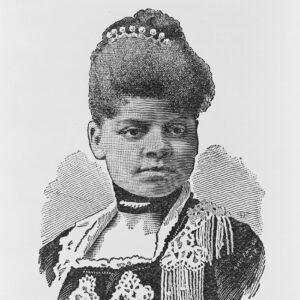calsfoundation@cals.org
The Arkansas Race Riot [Pamphlet]
“The Arkansas Race Riot” is a 1920 pamphlet that constitutes a critical source of information about the Elaine Massacre of 1919. Written by famed anti-lynching activist Ida B. Wells-Barnett, the pamphlet disputes the narrative offered by white political and economic elites in Phillips County—namely, that local African Americans had plotted to kill white residents in the area. Instead, Wells-Barnett recorded how Black sharecroppers and tenant farmers had formed a union, the Progressive Farmers and Household Union of America (PFHUA), for purposes of securing better payment for their cotton crop and explained how the massacre was a direct response to their union activities.
Ida B. Wells had been born into slavery in Holly Springs, Mississippi, and, after both of her parents died of yellow fever in 1878, she worked as a teacher in order to keep her siblings together. She later taught in Memphis, Tennessee, where she began writing for different newspapers, eventually becoming editor and co-owner of The Free Speech and Headlight. After the 1892 lynching of three men in Memphis, followed by the mob destruction of The Free Speech and Headlight offices following one of Wells’s columns on the subject of lynching, she relocated first to Harlem, New York, and then to Chicago, Illinois, all the while researching and publishing on the subject of lynching, including such works as Southern Horrors: Lynch Law in All Its Phases (1892) and The Red Record (1895), as well as conducting two lecture tours in Great Britain. In 1895, she married Ferdinand L. Barnett and continued her work exposing racial violence in America.
Wells-Barnett, in the opening chapter of “The Arkansas Race Riot,” explains that she was motivated to investigate what happened at Elaine (Phillips County) after receiving a letter, dated December 30, 1919, from one of the Elaine Twelve, those twelve Black men who were charged with murder and sentenced to death following the riot. In response, she took the train to Little Rock (Pulaski County) and “went to the address given in the letter and talked with some of the wives of the twelve, then went to the penitentiary and spent the day interviewing those men.” To get into the prison, she disguised herself and claimed to be a visiting cousin. She describes how, since their original imprisonment in Helena (Phillips County), those men “had been beaten many times and left for dead while there, given electric shocks, suffocated with drugs, and suffered every cruelty and torment at the hands of their jailers to make them confess to a conspiracy to kill white people.”
Instead of this conspiracy, however, the actual “crime” of these men, as Wells-Barnett details in the second chapter, “was to organize their members into a union for the purpose of getting the market price for their cotton, to buy land of their own and to employ a lawyer to get settlements of their accounts with their white landlords. Cotton was selling for more than ever before in their lives. These Negroes believed their chance had come to make some money for themselves and get out from under the white landlord’s thumb.” Wells-Barnett gives some of the background to the Elaine Massacre, revealing how Ed Ware had already refused to sell his cotton for cheaper than he believed it was worth and so had been threatened with violence, including a possible lynching. Too, she notes that it had apparently been a longstanding practice of white landowners to drive away Black sharecroppers as soon as the cotton had been brought in to avoid having to pay for labor. Wells-Barnett calculates that, through the theft of cotton and corn alone, “the white lynchers of Phillips County made a cool million dollars last year” off the massacre.
Wells-Barnett describes in brief the events of the massacre, including eyewitness statements by some of the Elaine Twelve. The fifth chapter, “What White Folks Got from Riot,” details some of the theft of personal property that occurred during and after the violence, including the apparent theft of furniture and clothes owned by Frank Moore and his wife by white landowner Bill Archdale and his family. She also devotes a chapter to the murder of brothers Dr. D. A. E. Johnston, Leroy Johnston, Dr. L. H. Johnston, and Gibson Allen Johnston, none of whom were connected to the union. Later chapters detail the legal saga of the sham trials in the Phillips County Circuit Court and the constitution and bylaws of the PFHUA. The pamphlet ends with a brief note about how the Arkansas Supreme Court had ordered new trials for six of the Elaine Twelve.
“The Arkansas Race Riot” was successful in spurring national support for the defense of the victims of the Elaine Massacre, eventually leading to the release of the Elaine Twelve and the U.S. Supreme Court case of Moore v. Dempsey. The pamphlet also remains a crucial source of information for historians as it provides, in their own words, testimony from some of the victims of the massacre.
For additional information:
Bay, Mia. To Tell the Truth Freely: The Life of Ida B. Wells. New York: Hill and Wang, 2009.
DuRocher, Kristina. Ida B. Wells: Social Reformer and Activist. New York: Routledge, 2017.
Giddings, Paula J. Ida: A Sword among Lions: Ida B. Wells and the Campaign against Lynching. New York: Amistad, 2008.
Jones-Branch, Cherisse. “Women and the 1919 Elaine Massacre.” In The Elaine Massacre and Arkansas: A Century of Atrocity and Resistance, 1819–1919, edited by Guy Lancaster. Little Rock: Butler Center Books, 2018.
Stockley, Grif, Brian K. Mitchell, and Guy Lancaster. Blood in Their Eyes: The Elaine Massacre of 1919. Rev. ed. Fayetteville: University of Arkansas Press, 2020.
Wells, Ida B. The Light of Truth: Writings of an Anti-Lynching Crusader. Edited by Mia Bray. New York: Penguin Classics, 2014.
Wells-Barnett, Ida B. “The Arkansas Race Riot.” Chicago: 1920. Online at https://archive.org/details/TheArkansasRaceRiot (accessed June 3, 2023).
Staff of the CALS Encyclopedia of Arkansas
 Civil Rights and Social Change
Civil Rights and Social Change Early Twentieth Century, 1901 through 1940
Early Twentieth Century, 1901 through 1940 Literature and Authors
Literature and Authors Ida B. Wells
Ida B. Wells 




Comments
No comments on this entry yet.